One of the most important and mandatory measures for the care of grapes is pruning vines in the fall. From the timing of pruning and the correctness of its implementation depends on the yield of the bush next year. Further in the article we will consider different options for pruning grapes for beginners and find out whether it is possible to pick leaves.
Table of contents
- Why do you need pruning a vineyard in the fall before winter
- Spring and autumn terms to cut branches
- How to cut the vine in the first year
- Tools to cut the bushes
- Diagrams of various types of pruning for old and young vines
- How can you make a rejuvenating trim
- Pruning grapes on an arch for beginners
- How to prune a running bush
- Vine care after trimming
Why do you need pruning a vineyard in the fall before winter
The need for pruning is as follows:
- Cutting off the extra shoots, winegrowers thereby redirect nutrients from the soil to healthier shoots.
- Increases frost vine;
- As a result of the autumn formation of the bush increases the yield. Growing up, young shoots will not prune neighboring ones;
- If you cut the branches regularly, the berries in the brush will be large in size and without loss of taste;
- The process of hiding the vine for the winter is greatly simplified;
- The process of fruit ripening is accelerating, since in spring the buds bloom before the active movement of the juices in the vine begins.
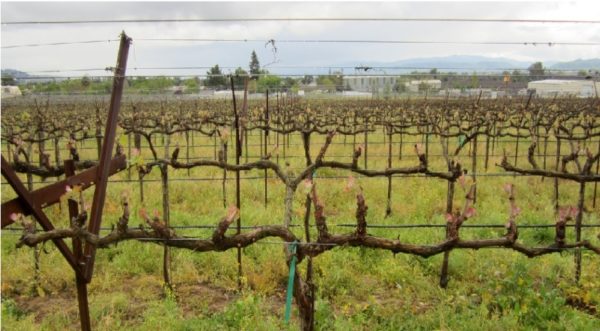
Spring and autumn terms to cut branches
Perform pruning of grapes, depending on the variety and region of growth. For non-roofed varieties, autumn pruning can be done at any time before the active growth of the shoots. In the case when winter is characterized by severe frosts, then cut the branches in the spring.
Autumn pruning for teapots are of two types:
- preliminary;
- the main.
Pre-pruning carried out in early October before the onset of frost. Should remove all green shoots. Avoid cutting shoots that are brown in color and crunchy when bent.
Main pruning runs from October 15 to October 30, that is, after the onset of the first frost. After a preliminary cut, 14 days should pass. After inspecting a bush, all dried, damaged, unripe, very thin shoots are removed, as well as those that have the wrong location. Those fruit vines that are developed better than others are pruned with arrows.
Spring pruning is done in the period when the air temperature will be + 3 degrees. Later, it is not recommended to carry out this procedure, since the cuts on the vine will tighten very slowly. This is one of the minuses of the spring pruning. Another negative factor is that with abundant flow of juice with a vertical garter, it can get on the fruit buds, which will significantly reduce the yield, and can cause trunk rot.
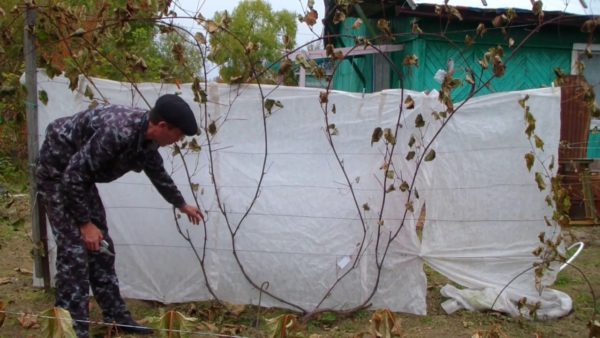
Before you begin spring pruning, you need to check the trunk for damage and assess the condition of the shrub in order to understand what load the trunk can be given. Spring procedure is divided into:
- short;
- average;
- long.
The difference in the number of processes growing from one root and their length. When pruning in the fall on the vine you need to leave the number of buds with a margin. In the spring, up to the moment when the bush begins to flourish, it is normalized. They make rejuvenation of the vine by creating a new sleeve, and the old one is removed, leaving no more than 10 cm.
The cut must be done in the direction of movement of the juice. In this case, the young shoot is developing rapidly. Along the way, you must leave a few substitute vines. They will serve in the formation of the vine in future seasons.
By the summer, experienced winegrowers already quite clearly understand how many clusters must be left on the vine in order not to give an extra load to the bush. The extra clusters left on the vine will lead to the exhaustion of the bush, and their insufficiency to the formation of extra stepchildren.
Advantages of summer cutting:
- helps to create the required vine size;
- remove excess green mass pulling juices;
- to create free access of air and light to the clusters during the filling of the fruit.
At the initial stage of development, it is necessary to remove all weak processes, after the formation of 2 brushes, pinch the top of the vine after 5 leaves. Long vines do not leave, because the berries will be sour. Also remove all stepchildren, mustache and extra leaves. In August, in order to accelerate the ripening of fruits, it is necessary to carry out a hard pruning of the shoots.
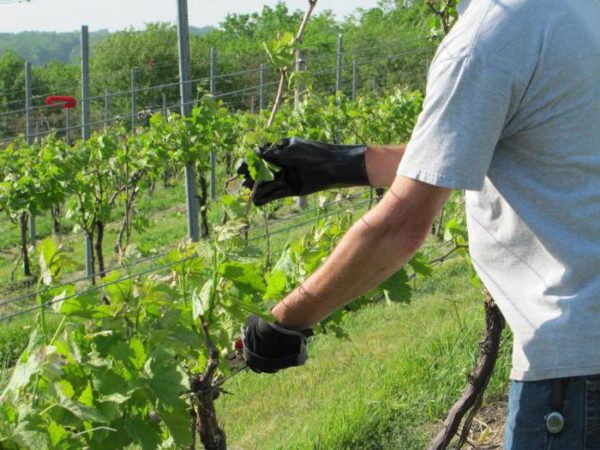
How to cut the vine in the first year
Crop young grapes in order to:
- sleeve formations;
- growth stimulation;
- ensure a good harvest.
A young bush, aged 1 year, removes the tip, leaving only two to four buds. Retreat 1 cm from the last eye up and perform a cut. This will be the basis for the fruit bearing arms for the next year.
The vines of 2 years of age form a knot of substitution by cutting the process into two ocelli. Leave 4 to 6 buds on another process.Pruning a bush in the same way as in the first year of life. At the same time, the harvest will be only in a year, and the bush will become much stronger.
When pruning a three-year bush, the knots of substitution and the fruitful process are formed. The knot of substitution should be located below the main shoot and it should be trimmed with 3 eyes. At the main shoot, five to ten buds should be left. In some varieties can be left on the escape from 10 to 12 buds. With this procedure, a bush for three years forms 4-6 fruit-bearing arms. This is quite enough for aging crops.
The purpose of the autumn procedure of young seedlings is to properly form a bush. Many novice growers make a mistake without cutting the first two years, not wanting to delay the harvest. This leads to the fact that the bush turns out too thick and the excess shoots are pulling a large amount of nutrients. In addition, the uncircumcised bushes will be harder to cover for the winter.
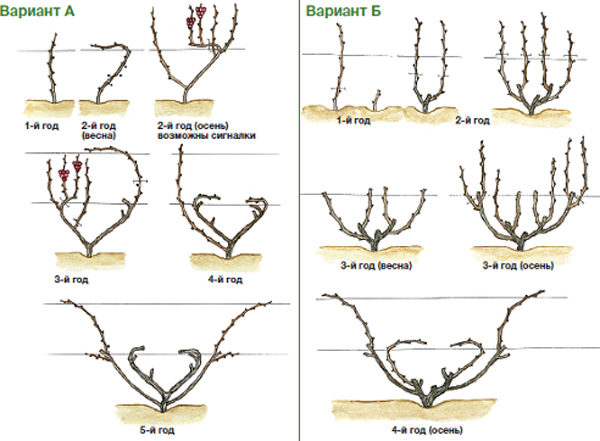
Tools to cut the bushes
For the proper pruning of the grapes you will need the following tool:
- garden pruner;
- sawing, hacksaws;
- garden knives.
Secateurs are used to remove one and two-year bushes that have a vine thickness of no more than one and a half centimeters. In order to make a more even cut, use secateurs with two blades.
If the thickness of the perennial vine less than eight centimeters is used for trimming bow saws. With a thickness of more than 8 cm. Trimming is performed with a hacksaw. In hard-to-reach places it is recommended to carry out by means of the delimber.
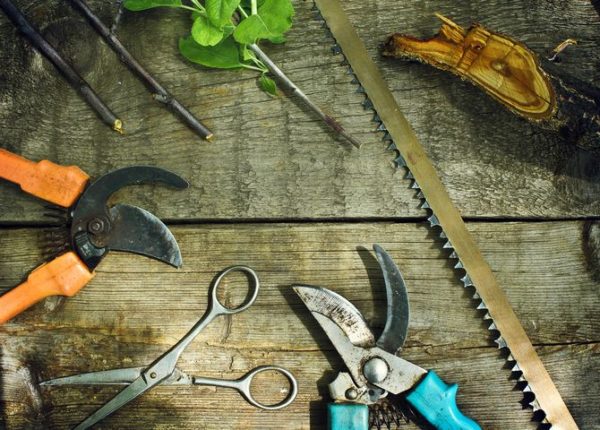
Diagrams of various types of pruning for old and young vines
Currently, there are several types of forming trim:
- fan;
- bowl-shaped;
- capitate;
- cordon;
- unilateral and bilateral.
Fan pruning in spring
The convenience of this pruning is that with this option it is easy to replace the sleeves and regulate the number of fruit buds, and it is also convenient to cover the vine for the winter. On the trellis one-lane place from two to four sleeves, and on the two-lane from 4 to 8. On each sleeve leave the knots of substitution and 2-3 fruit arrows. The length of the sleeves should be different. This contributes to good lighting of the vine.
In the second year, if one process has developed, then 2 to 4 buds are left on it. If there are two, then 2–3 buds are left on each. The third process must be cut short. It will serve for the formation of the following processes. If there are 4 shoots, then of them must be formed sleeves.
In the third year, 3 eyes are left on each shoot so as not to burden the vine. On each sleeve, 1 inflorescence should be left to control the quality of the fruit. It is also necessary to form fruit links on the new sleeves. Provided that the vines are 2 years thicker than 7 mm. you can leave 6-7 buds on the shoots to form new shoots.
In subsequent years, the shape of the bush is maintained by cutting arrows and fruit shoots from which the harvest has been removed. Spend in the summer months. The sleeves must be renewed every seven or eight years.
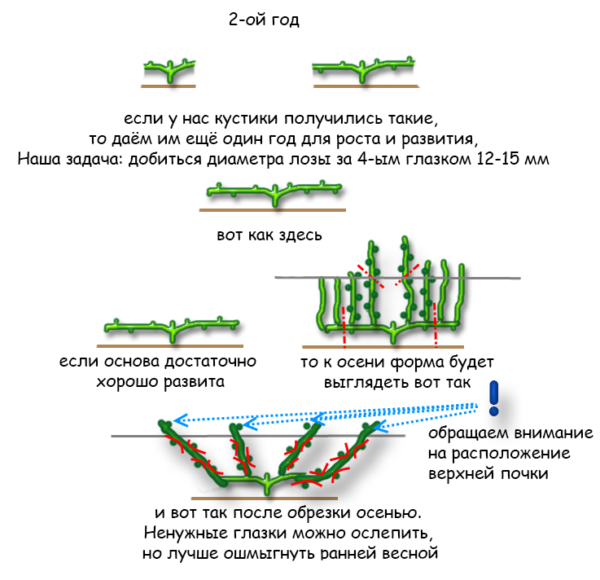
Cup shape
This trimming is used in case the stakes are used as a support for the bush. The size of the bowl depends on the size of the sleeves. If the sleeve is up to 50 cm long, then the bowl will be small.With a size of 50 to 70 cm - the average bowl. Over 70 cm. - a large bowl.
The disadvantages of this type are:
- twisting the vine will worsen the supply of useful substances;
- leaves shading each other and receiving a small amount of light;
- poor air access.
The technique over the years is identical to fan pruning.
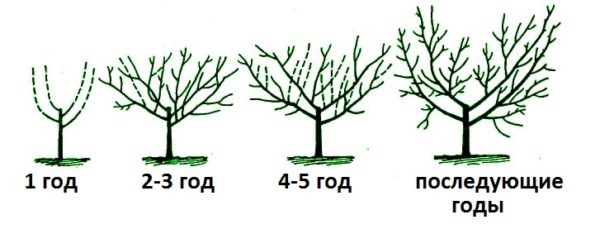
Crown shrub
Use this form for grafted bushes. On a sapling trim the sleeves. On the head there are five knots with two buds on each. From them vines will grow in the future.
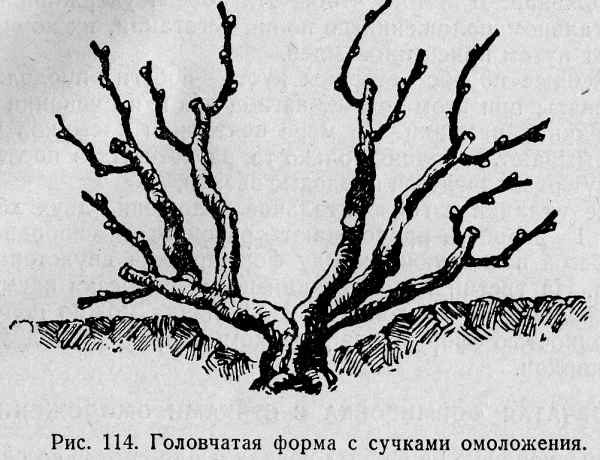
Cordon shaping bush
1st year on the bush leave 2-3 buds to form powerful processes.
2nd year with the onset of spring young sleeves will grow, they will serve as a cordon. After bud break, thinning is necessary. The processes are left every 30 cm. Replacement knots are made from the grown shoots, leaving 2-3 peepholes on them.
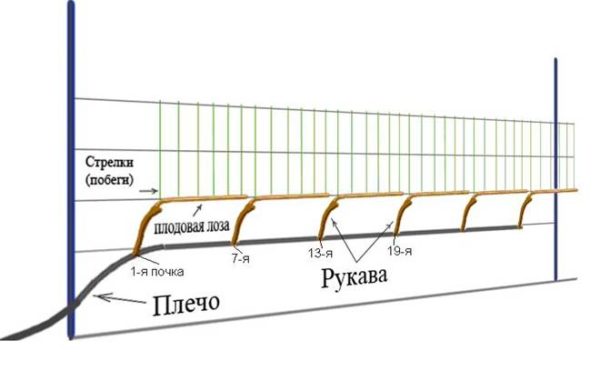
How can you make a rejuvenating trim
There are two methods of rejuvenation - full and partial.
Partial rejuvenation You can perform when the sleeves are formed at the bottom of the bush. When pruned in the fall they leave two buds. The old sleeves are partially cut, and some are cut according to the scheme:
- leave 6-7 buds on the upper shoot;
- the lower shoot is cut into knots of substitution.
In subsequent years, from the powerful deputies form the sleeves of the second and third row. One part of an old vine is cut, and on the other 5-6 eyes are left.
In the 4th year, the old sleeves are removed completely. Sections cover garden pitch. The young processes form in the new bush.
Complete rejuvenation. Full cutting of old bushes leads to the awakening of the buds on the bush and stumps. In the spring there is an active growth of shoots and under favorable conditions, they grow to two meters. Next year, the first crop is removed from the shoots and a new bush is formed. Cutting off old sleeves makes it possible to rid the new bush of the pests that have formed nests in the old sleeves, as well as update the above-ground part of the bush.
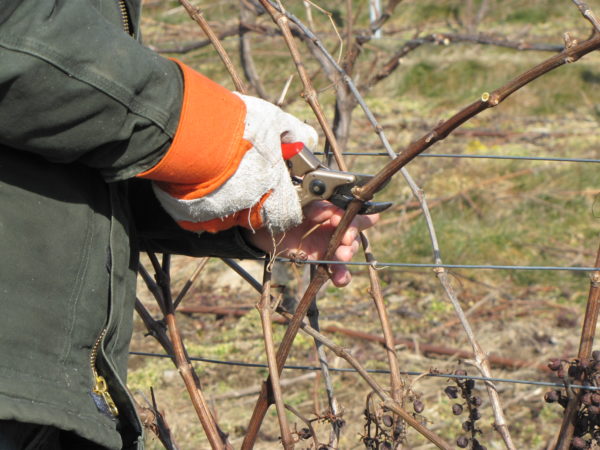
Pruning grapes on an arch for beginners
There are several forms of pruning grapes on the arch:
- semi-covering;
- cordon;
- cordon odnoplechy;
- fan sleeve.
If the grapes are not covered, in this case, fit half-hidden formirovka. With this shaping, vines are set aside from the main sleeve, which are located on the upper trellis. At the bottom of the trellis is a spare sleeve. It should be the same length as the main one. At the very bottom of the bush it is necessary to leave a shoots shoots and cut it once a year - in the fall. Together with a spare escape it is sheltered for the winter. In the case of a successful wintering season, in summer, shoots grown from the spare arm are cut into 2-3 buds and several powerful shoots are grown from them.

How to prune a running bush
It is necessary to carry out trimming of the started bush in the early spring or late fall. First you need to remove the old, damaged vines. To do this, make a cut with a sharp knife on the vine. If the vine is incised green, then it is alive. If the vine is notched when the incision is made, then the vine is notched again, closer to the base.If the color of the same vine is removed completely. Pruning is recommended step by step.
1st step:
- It is best to pruning before the first frost or in the spring before April 1. It is necessary to remove all underexposed or dry shoots, cut out all parts that have gray or black bark color. If the sleeve is frozen out, then it is removed completely.
- After removing all extinct areas, inspect the remaining shoots. Leave those on which there are 10-12 buds and the thickness will be at least 5 cm. If there are few such shoots, in this case, leave everything. Of the short ones, only those that are not less than 5 cm thick are left. Five of them are left for 2 running meters of the trellis. They should be located along the trellis evenly.
- Annual shoots are removed by 85%.
- In summer, the buds of perennial sleeves will wake up and give a large number of shoots. These shoots need to remove everything. As a result of such pruning, the harvest will not be large, but the taste of the fruit will be much higher.
2nd step:
- In late October, before the onset of frost, leaves, mustaches, and stepchildren should be cut off from the shoots. It is also necessary to remove all weak shoots whose thickness is less than 4 cm.
- In subsequent years, when pruning to form fruit units.
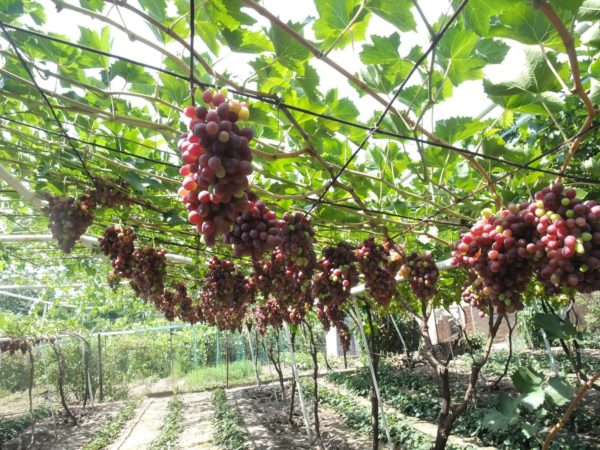
Vine care after trimming
If pruning was done in the summer period, then after this procedure before the autumn pruning it is necessary:
- Perform pinching. It is performed by shortening the shoots, leaving 5 leaves over each bunch of grapes, and also pinching the tip of the vine to stop growth.
- Tying shoots grown over the lower trellis more than 22 cm.
- Perform watering and feeding;
- To carry out the minting of the vine, leaving on the shoots to cut the top 14 leaves.
- To carry out the treatment of diseases and pests fungicides. For this, it is best to use Topaz. To control pests, it is necessary to use insecticides. Processing is carried out 3 times per season.
After the autumn pruning is necessary:
- Perform abundant watering so that the soil is well saturated with moisture before winter.
- Well loosen the ground near the bush to prevent moisture stagnation, and to ensure the access of oxygen to the roots.
- To introduce into the soil humus or rotted manure.
- With the onset of the first frost shelter grapes for the winter. For this fit pine branches, sawdust, peat, hay.
Performing the correct pruning of bushes and carrying out constant care of the vineyard, you deservedly can count on a good harvest in the coming year. You can prune any grapes, including the Isabella variety.
